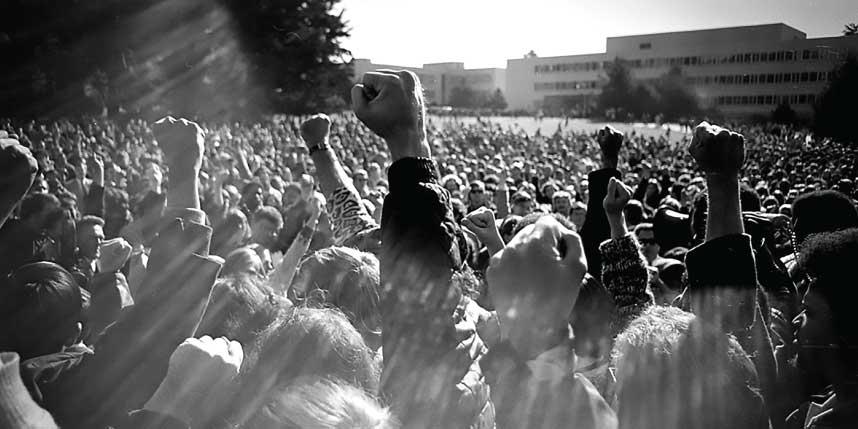In the 50 years since the historic SF State student strike resulted in the country’s first college curriculum dedicated to ethnic studies, the university’s education has become the most progressive in the country. But some still feel that SF State’s academic decision-making lacks student involvement.
In the lead-up to the 1968 student strike, the Black Student Union and the Third World Liberation Front issued a list of 15 demands, including the establishment of a curriculum that went beyond the Eurocentric education they received.
“They were going into educational situations that were designed for white, middle class children going into a white, middle class economy,” said SF State archivist Meredith Eliassen. “They wanted a place at the table in higher education.”
Among the strikers was 19-year-old Juanita Tamayo Lott, who co-founded Filipino American Studies at SF State in 1969. Tamayo Lott just released a memoir written about her participation in the strike titled “Golden Children: The Legacy of Ethnic Studies, SF State.”
“We were fighting the narrow white Anglo Saxon Protestant [curriculum],” she told the Xpress. “What we were saying was, ‘That only starts in the 1500s.’ We said, ‘We will help build the curriculum.’”
Starting on Nov. 6 1968 and over the next five months, thousands of students, faculty and staff walked out, the university president was removed, then-Governor Ronald Reagan demanded that the strikers clear out, and police battered and jailed hundreds of students.
The administration finally reached a settlement with students on March 21, 1969, and as a result, what’s now the College of Ethnic Studies was established the following fall semester.
While the university’s curriculum has become more inclusive since 1968, some still feel students don’t have enough involvement in their education.
Garrick Wilhelm, vice president of External Affairs for Associated Students Inc., said he feels the administration doesn’t do enough to involve students in social justice.
One problem is that campus activities and events must be pre-approved by administration. The controlling measures are among the downsides of the strike’s legacy.
“There’s a historical trauma in the administration,” Wilhelm said. “Time, place and manner restrictions are arms-length measures that keep the administration on guard.”
Wilhelm, who also teaches the Experimental College’s “Homelessness: Rhetoric of a Social Program” course, believes there aren’t enough opportunities for students to contribute to discussion.
“It’s still traditionally how classes are held. You take notes in class, then take a test,” Wilhelm said. “It’s an efficient way to teach. It’s not effective.”
Wilhelm gave an example of student involvement in his Experimental College class.
“Every class takes and deconstructs homelessness narratives,” Wilhelm said. “There’s no lecturer.”
Tamayo Lott said the ethnic studies curriculum strayed from the vision she had when she was trying to craft a broader educational program.
“What I’m saddened to see is that we started off big, we were interdisciplinary,” she said. “If you’re teaching in a College of Ethnic Studies, you ought to be able to teach an introductory course across all the different ethnic groups. You got to know how everything relates. What I’m seeing in ethnic studies, and I see this in higher education, the higher you advance, you become more specialized.”
Five prominent SF State strike organizers said during a panel discussion in Oakland last month that they have never been invited to College of Ethnic Studies commemorations. That’s indicative of the co-opting of the ideals they first brought to the fight so many years ago, said organizer Dr. James Garrett.
“The structure now is trying to preserve ethnic studies for the academy,” he said. “Our struggle was trying to create institutions that had transactional relationships with various communities on the campus. So that’s a different set. If your life is trying to build relationships, that’s one thing. If you’re trying to build a career, that’s another.
“Trying to build a career in the academy, what you focus on is the academy’s needs. In order to keep your career, you have to push certain people aside.”
Despite the perceived problems with the curriculum, many of today’s students recognize that it has come a long way, said Tachelle Herron-Lane, Associated Students Inc. vice president of University Affairs.
“Now you come and [that history is] embedded into the curriculum,” Herron-Lane said, a member of both the BSU and Equal Opportunity Program. “If you’re a student of color, you can still learn about a scientist in your culture.”
For Herron-Lane, upholding the kind of environment conducive to student voices, especially for students of color and non-binary students, means listening and advocating for them through measures such as the campus climate survey.
“My aunt was attending SF State at the time and she was familiar with the shutdown,” Herron-Lane said. “That trickled onto me and resonated in my heart.”







